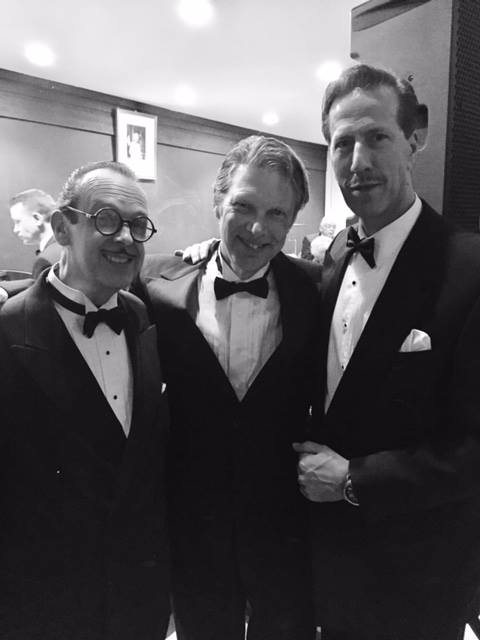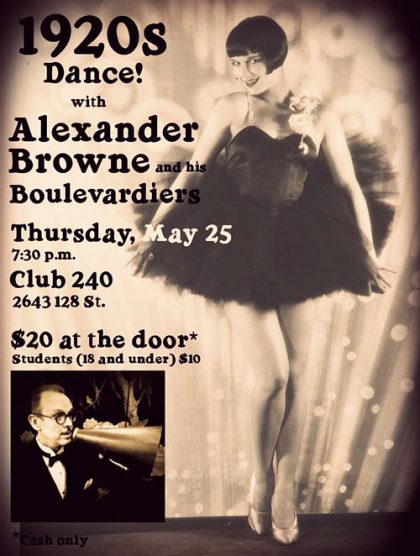
What a treat to be part of this ensemble. The octet’s songbook is strictly 1920s-30s, so very early big band era, which is perfect for my 1927 “Jazz Pirates” Leedy kit. The audience cuts a rug, and with tuxes and pomade mandatory, we all look especially dapper. Looking forward to swinging again soon!

June 14, 2025 Fun outdoor gig today for White Rock Jazz and Blues Festival with Alex Browne and his Boulevardiers. Sight reading these charts, many for the first time, with plenty of surprises.
Another drum-centric angle, playing my 1927 Leedy kit. Thanks Doug Schober!
To quote the immortal songwriter Irving Berlin… “C’mon and hear Alexander’s Ragtime Band”!
A long-time champion of the big band style in Vancouver area venues with his Aristocrats of Swing, crooner-bandleader-arranger Alexander Browne has returned to his first musical love – the jazzy, syncopated, devil-may-care dance band sound of the 1920s and early 1930s – with his new group, the Boulevardiers.
It was an opportunity to meet and get to know the original megaphone crooner, Rudy Vallee, Alexander recalls, that provided the original inspiration for him to start his own band.
That was the beginning of a decades-long journey of exploration that has led him to uncover untold hidden treasures of musical history in stacks of orchestrations passed on by former leaders and bandsmen.
Now, with The Boulevardiers, he’s sharing the original, authentic sounds of the most exciting time period of all – the Prohibition Era (1920-33).
“It was a wild and crazy time that still speaks to us today,” Alexander enthuses.
“Flappers and their ‘sheiks’ challenged the social conventions of their parents’ generation, sexy vamps were slinking their across the movie screens, and bathtub gin and jazz were supposed to be leading everyone down the path to degradation. Skirts got shorter, aeroplanes flew further, buildings grew higher, the movies learned how to talk, and the stock market kept on rising until its inevitable fall.”
All of this found its way into the music that poured forth from Tin Pan Alley – and which Alexander brings back, vividly, for new generations – from the vo-do-de-o-do lyrics of songs like Crazy Words, Crazy Tune to the heroines of If You Knew Susie (who didn’t balk at going riding in motor cars) and Louisville Lou (the vamping baby), to the fellow with Happy Feet and the people who murmured Let’s Do It or told Little Little White Lies or danced the Cuban rumba to Mama Inez.
Complimenting Alexander’s smooth vocals are the stellar instrumental skills of the Boulevardiers: trumpeter Henry Christian (Aerosmith’s Marguerita Horns), trombonist Jeremy Berkman (The Turning Point Ensemble, A Touch of Brass), versatile reedmen Tony Sheppard and Graham Howell, pianist Angus Kellett, tuba player David Sabourin (of A Touch of Brass and Tapestry Music fame) and drummer John Cody (Lee Aaron).
 May 17, 2017
May 17, 2017
ALEX BROWNE is an entertainment fixture on the Semiahmoo Peninsula. From his ongoing entertainment editor position with the Peace Arch News, his performances at the White Rock Playhouse and his all too infrequent musical performances Alex truly is an arts man around town. Next Thursday (25) Alex will perform with his orchestra The Boulevardiers at the Crescent Beach Legion.
When did you love for music begin Alex?
I was surrounded by music as a youngster, growing up in Sussex in southern England. My Dad (a former big band guitarist/vocalist) was a columnist and feature writer for The Melody Maker and Picturegoer (he interviewed everybody from Frankie Laine and Johnny Ray to Frank Sinatra and Marilyn Monroe), and later started his own musicians’ magazine, Crescendo, which became a favorite of top U.S. players like Buddy Rich. My brother was a jazz/show drummer who played several seasons with a band in Paris. They used to bring home sample review records, and I was allowed to keep any that appealed to me. I loved classical music and some pop, but the first band that really clicked with me was The Temperance Seven. They were produced by George Martin (pre-Beatles) and played music of the 1920s that was surprisingly authentic in sound and arranging style – not like the glitzy inauthentic Roaring ‘20s recreations that had a vogue in the U.S. in the late ‘50s and early ‘60s. Temperance was (and still is) a really oddball group, very iconoclastic in the context of early ‘60s pop like Elvis, Fabian, Frankie Avalon, and they also had a satirical edge to them (not unlike Beyond The Fringe and early Monty Python) that also gently ridiculed the British Establishment. I didn’t understand any of this as a six or seven year old – I just loved the tricky arrangements, which later prompted me to seek out genuine ‘20s and ‘30s artists.
You have been performing with your “big band/orchestra” for a number of years now. When did this chapter of your performing life begin?
It really goes back about 30 years to when I first moved to White Rock, and did gigs at Charlie Don’t Surf and Dean Gibson’s Piccadilly Station restaurant on the waterfront fronting my own small group. I’d been immersing myself in 1920s and 30s music for years, singing, playing cornet and stand-up bass, and jamming with my Dad and other musicians, but I was never very happy as a sideman. It all came down to the arrangements – wanting to have the interesting effects I’d heard on ‘78s and re-issues but which always get lost in more informal playing situations. I’d been collecting old band stock arrangements since I was in my early teens (you could still find them in thrift stores at that point), but, as a self-taught musician, it took me a long time to really understand how they were put together to the level that I could make a stab at restoring missing parts or use them the way old-time band-leaders did. I started with a pre-Swing group, which grew into a small big band by the time of the big commercial Swing revival of the 1990s. With an extended book, thanks to the generosity of veteran musicians I’d met, I ended up playing everything from the 1920s to the mid ‘50s when I created the Swing Sunday event at Washington Avenue Grill. I was also doing corporate and Hot Jazz Club gigs at the time.
How large is your musical ensemble? All all the members from the surrounding area?
We’re an eight-piece group, including me, or nine if you count Ed Johnson (a Semi grad) who’s a fabulous musician in his own right and who I’ve been lucky enough to have as a sound-engineer for years. Most of the musicians are people I’ve worked with for years and they’re all top freelance talents in the Vancouver market. Surrey’s Henry Christian, on trumpet, is a first-call man for the orchestra of touring Broadway shows in Vancouver and he’s played every kind of gig, up to appearing on Aerosmith albums! I have to negotiate for the services of South Surrey drum star and music collector John Cody (he plays his own authentic 1927 kit) with the legendary Lee Aaron – he’s her drummer of choice. David Sabourin on tuba has had a highly distinguished career as a concert musician and created White Rock’s Tapestry Music, which is hugely influential in keeping music alive through the younger generations. Tony Sheppard (alto sax/clarinet) from Richmond and Vancouver’s Graham Howell (tenor sax/clarinet) are both fabulous reed men who are also fine teachers and mentors. Jeremy Berkman (trombone) is a highly-respected Vancouver musician and one of the founding members of the Juno-nominated Turning Point classical ensemble and also plays in the Vancouver Opera orchestra, like Angus Kellett (on piano, also from Vancouver) who plays a lot of opera and show gigs and excels at just about every music style known to man.
I had the pleasure of seeing one of your recent performances at the Crescent Beach Legion. There was a very interesting aspect to that performance in that the music in large part you and your orchestra performed was donated to you by a lady in the audience. Tell us about the back story on how that occurred.
I’ve known Cindy Sleeman for years through White Rock Players Club shows we both worked on – including Scott Wheeler’s The Wild Party – and also on movie gigs for which she was a scenic artist. Her late mother, distinguished Canadian composer Anita Sleeman, was director for years of the Ambleside Community Orchestra, and at one point somebody donated a bunch of scores to her. Some she was able to use, but there were several boxes of 1920s and early ‘30s dance band arrangements that sat in boxes for years. When Cindy was going through her mom’s things recently, she found the charts and got in touch with me, asking whether I might be able to use them. She sent me a cell phone shot of the first page of one the charts and I almost had a seizure. There were things there I’d been wanting to find for decades. She very generously donated the boxes to me with the proviso that I play the pieces and introduce them to new generations. It was a very serendipitous, particularly since I’d already decided to shift my musical focus back to the pre-Swing era!
In watching you perform this music from another era, it almost seems like you transcend the moment and virtually channel the music of the era. Who are some of your favourite composers and performers from those days gone by?
I love the well-known jazz musicians of the 1920s such as Louis Armstrong and Bix Beiderbecke, and bands such as Duke Ellington, Fletcher Henderson, King Oliver and Cab Calloway. But I also love more commercial groups like Paul Whiteman’s Band, The Virginians, the Jack Hylton Orchestra (I play some of their original charts, cut down for our instrumentation), Jack Payne’s Band, Ambrose, Roy Fox and Bert Firman’s Rhythmic Eight from England, early Guy Lombardo and the Royal Canadians, , Ben Selvin, Johnny Hamp’s Kentucky Serenaders and Nat Shilkret and his Victor Orchestra. I use a megaphone for my vocals as a tip of the hat to the original crooner idol, Rudy Vallee, who did much to reshape dance music in the late 1920s and early ‘30s. I actually had a chance to meet and hang out with him during one of his visits to Vancouver (although I soon discovered he was more interested in talking about past romantic conquests than discussing musical concepts!). I like composers such as Gershwin, Cole Porter and Rodgers and Hart, but I enjoy reviving some of the great tunes by people like Harry Akst, Walter Donaldson and DeSylva, Brown and Henderson.
Will we see a new show next week when you make your return to the Crescent Beach Legion/Club 240?
It’s an evolving book and playlist, which will introduce some new/old material in my never-ending search for a balanced program. I have to be careful how much I push this – we have several hundred charts we could be playing but it takes time for the band to decipher and assimilate all their quirks and peculiarities. Most of the book is new to us this year and I’d like the guys to get comfortable with it, rather than steaming up their spectacles with too much furious sight-reading.
You have a young daughter so I am assuming you are exposed to the music of today. What artists have grabbed your attention over the past decade.
I hear a lot of everything. I can admire just about anything in any idiom that’s authentic and passionate, but not a lot of Top 40 (or is it the Top 7 nowadays?) with its go-nowhere hooks, endless repetitions or lyric-driven duh-duh-duh-duh-duh one-note melodies (our daughter, Savannah, shuns them too). I respect some contemporary performers like Adele and Bruno Mars, but whenever I hear any oldies from the ‘70s or ‘80s I realize again just how much our popular music has been diluted and denatured over the last couple of decades. At our house, the playlist is very eclectic, ranging from Katherine’s Beats Antique tribal fusion dance music, to artists that Savannah has discovered like the British avant garde folk band Moulettes (who we saw in White Rock as part of the TD Concerts series last year), to family favourites like Tom Waits, Melody Gardot, Jill Barber’s French album and Django Reinhardt’s gypsy jazz. I also very much like Tuba Skinny, a young group from New Orleans who bring an infectious energy to traditional jazz.
If you were being sent to a Desert Island and you could only take 5 albums with you, what would they be?
I have the LPs in our living room ready to go! – Young Bing Crosby, Bing Crosby in Hollywood Vol. I, Jack Hylton, Original Sounds of the 30’s, Ambrose and his Orchestra.
What song is the soundtrack to your life?
I guess I would have to say the song I have chosen as the opening theme of The Boulevardiers – Beyond The Blue Horizon. It’s a song from 1930 that has always appealed to me – full of hope for travel and blue skies and new adventures (and a suitable antidote to my gloomier side!)
Thank you for sharing your history with us Alex, in addition to you concert next week you are involved in an event at White Rock’s Uptown Pop Up Gallery beginning Thursday (18) Tell us a bit about your involvement in 5 Nuts & A Squirrel.
My wife, artist/designer/tribal fusion dancer Katherine (Kat) Siemens is one of the three highlighted multidisciplinary artists – along with our friends, painter, sculptor and jewelry-maker Alicia Ballard (of Outside The Box fame) and Bryce Willushaw, a talented painter, graphic artist and video consultant – so I’m pretty closely involved in supporting the venture, entitled Life As Art: Fashion, Function and Fusion. Over the course of the month it will feature an intriguing variety of painting, jewellery, fabric arts, dance and literature, demonstrations and live events. My actual role is as a special guest, along with Jill Tunbridge of Flamenco del Mar, who will be conducting some flamenco dance workshops and who has also written a poetic fantasy Fairy of the Night and Still from which I will be reading excerpts during the show. I will also be reading excerpts from my own soon-to-be published book Rough Shadow and Other Stories, a series of linked noir mysteries set in the dark milieu of Vancouver in 1950. But that’s a whole other story!
David Chesney – Editor/Publisher
© Copyright White Rock Sun



